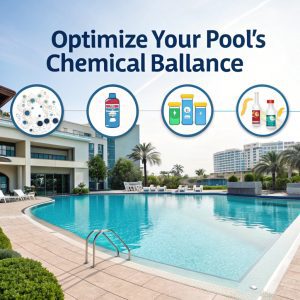
A refreshing dip into your pool on a hot summer day is the ultimate relaxation. However, have you ever stopped to think about what’s really going on behind the scenes?
You’re probably aware of chlorine levels and pH balance in your pool.
But if not, let me tell you why alkalinity management is key.
Bridge to the article :Alkalinity plays a crucial role in maintaining stable water conditions that allow for clear visibility, soft skin, and safe bathing experiences. Without proper care however many pools become murky messes or even create health issues.
Bridge 2 Article: In this post we will explore the best practices of managing your pool’s chemical balance to achieve crystal-clear water – no matter where you live.
The Hidden Enemy – How pH Levels Impact Your Pool’s Health
Maintaining a balanced chemical balance in your pool is crucial for creating crystal clear water, but there’s a specific challenge that can quickly throw off this delicate harmony – pH levels. If left unchecked, pH imbalances can have serious consequences on the overall health of your swimming pool.
Pools with consistently high or low pH levels are at risk of developing an unpleasantly greenish tint and eye irritation from chlorine fumes, which will make it difficult to enjoy a relaxing swim. This is largely due to how pH affects the balance of other chemicals in the water. For instance, when pH gets too high, it can increase alkalinity and decrease the effectiveness of disinfectants like chlorine.
A perfect pool requires very specific levels of each chemical – anything off from these precise balances will disrupt this delicate harmony. Alkalinity plays a huge role here as well; if your pool’s water has an excessively high or low reading on that meter, it can have far-reaching consequences such as corrosion and cloudy water which is really unpleasant for swimming.
Understanding the pH levels’ impact on pool health helps create healthier environments to enjoy for everyone who comes into contact with them.
Diagnosing Alkalinity Imbalances with the Right Equipment
In Dubai‘s scorching desert climate, maintaining optimal chemical balance is crucial for your pools. Alkalinity imbalances can wreak havoc on your pool’s water chemistry, leading to issues like algae growth and staining.
Diagnosing these imbalances requires accurate testing equipment and a basic understanding of pH levels. But fear not – it doesn’t require you to be an expert in chemistry just yet! Here are some practical steps to take:
The Alkalinity Challenge: A Game of Pool Chemistry
When was the last time you checked your alkalinity levels? If it’s been too long, you might be facing a silent killer like high or low alkalinity. Imagine your pool as an underwater ecosystem – balancing pH and alkalinity is essential to maintain that delicate balance.
The First Step: Get Your Act Together with Accurate Testing
Before diving into the world of testing equipment, consider this: What if you had access to a simple, accurate test kit? That’s exactly what Dubai pool owners need! Here are some key choices:
* pH Test Kits vs. Alkalinity Probes:
+ Digital kits offer fast results and ease of use.
+ Manual probes provide more detailed readings for expert analysis.
For instance, let’s say you’re faced with a pH reading that indicates your water is heading towards being too alkaline (above 8). A simple test would show high levels of hydroxide ions. This calls for action – not just adjusting the pH but also considering other factors like chlorine levels.
Tackling Alkalinity Imbalances: Tips and Tricks
Here’s how to tackle these imbalanced waters:
* To interpret pH levels, remember that too low or too high readings can lead to issues like algae growth, staining, and cloudy water. Don’t risk it – master the art of reading your test results.
* For titration tests:
+ Calculate hydroxide ion levels using your equipment’s provided formula (e.g., HCO3- + CO32-, = [OH-]).
+ Use visual aids or charts to ensure accurate readings.
Achieving optimal alkalinity balance is key. This not only helps reduce chlorine consumption, increasing water clarity and enhancing the overall pool experience but also saves you time and resources in the long run by preventing issues that arise from unbalanced chemistry.
Regularly monitoring your pH levels alongside other factors like chlorine will give you valuable insights to make informed decisions – ultimately leading to a healthier, clearer pool.


Balancing Acts – Understanding the Role of Baking Soda and Soda Ash
Understanding alkalinity is crucial for maintaining pool water quality. Think of it as your pool’s best friend, working behind the scenes to keep swimmers healthy and happy.
Baking soda (sodium bicarbonate) helps increase alkalinity levels by adding more hydroxide ions into solution. When you use baking soda, consider how it will affect pH balance in your pool water. Too much or too little can lead to poor water quality, such as red eyes (conjunctivitis) and irritated skin.
The relationship between baking soda and alkalinity is vital for a well-balanced swimming environment:
- Regularly test your pond’s alkalinity levels
- Monitor changes in temperature and humidity
Use the correct dosage of baking soda per pool type to maintain optimal results
Mismanaging these chemicals can have severe consequences. If you don’t handle them correctly, it may lead to serious problems for swimmers.
In Dubai, maintaining a stable pH level is essential due to water usage differences between cities like Abu Dhabi and Ras Al Khaimah. For instance:
- In high-temperature locations with heavy sunlight exposure (like the desert), baking soda levels can quickly spike
Use these steps daily: Regularly test alkalinity levels using a pool testing kit.
Here’s how you measure your alkalinity level correctly
Maintain good health for people who swim in Dubai pools by following this simple method:
- Purchase or get an accurate device to gauge the amount of bicarbonate (baking soda) present, usually measured as ‘Total Alkaline’
- Regularly check pH levels.
- Use a test strip if you want
To avoid common problems related with these compounds like excessive acidity reactions we must not forget:
Beware when handling baking soda because it can cause skin irritation
Regular testing of your pool water and dosage instructions should help prevent unpleasant incidents such as eye strain, respiratory issues, or other symptoms resulting from poor air quality.
Coping with High and Low Alkalinity Spikes
Optimizing your pool’s chemical balance starts with mastering alkalinity management – a crucial step in maintaining crystal clear water in Dubai pools.
Before diving into optimizing your pool’s chemical balance, understanding alkalinity management is vital for maintaining healthy and safe swimming conditions. High levels can lead to cloudy or discolored water, while low levels may result in scaling damage to equipment or pipes. For instance, high alkalinity levels (above 180 ppm) can cause eye irritation and skin rashes for swimmers.
Conversely, when you notice low alkalinity spikes are less common than pH fluctuations that lead to corrosion issues with pool equipment. Scaling buildup on the surfaces of pipes and pumps is particularly prevalent in water containing excessive bicarbonate concentrations.
Regular testing becomes less effective if you only check the surface of the water; instead, take a sample from deeper areas (e.g., 4-6 feet below the surface) and measure pH levels at different times of day. Monitoring alkalinity levels daily can help identify potential problems before they escalate into severe issues that affect pool performance or create unpleasant swimming conditions.
To cope with high and low alkalinity spikes, it’s essential to implement a strict testing schedule. Adjusting the dosage of sanitizing agents in accordance with test results helps prevent pH imbalances from occurring.
Regular partial water changes will also help maintain your pool’s chemical balance and prevent scaling damage. You should follow manufacturer’s instructions for adding chlorine tablets as well.
Making adjustments based on regular testing and feedback from a qualified pool technician ensures that your water is always safe and clean.
By staying up-to-date with regular testing, making informed dosing decisions, and consulting an expert when needed – you can keep your Dubai pool’s chemical balance in check.
The Myth Behind Buffering Agents in Pool Chemicals
The myth that buffering agents are a magic solution for balancing pool water chemistry is common among Dubai-based pool owners.
Buffering agents can provide short-term relief, but they’re not a reliable long-term fix. They offer temporary fixes at best and don’t address underlying problems like high alkalinity levels. Alkalinity imbalances above 200 ppm can lead to pH instability, causing chlorine doses to fluctuate wildly. This creates an environment where algae thrives.
Regular testing for pH, alkalinity, and chlorine residuals is crucial in preventing these issues. It’s not rocket science: just a quick dip into your pool with the right test strip or kit will reveal potential problems before they become catastrophic.
Think of it like checking your car’s dashboard lights – some signals are more urgent than others (e.g., the low gas light vs. the warning light that says “oil leak”). Similarly, regular pH testing is key to avoiding issues like sudden spikes in chlorine demand.
By taking control of these variables, you’ll have crystal clear water that is not only safe but also comfortable for swimming. So, ditch those buffering agents and get familiar with your pool’s chemistry.


Making Sense of Phosphate Levels for a Healthier Pool Environment
Consistently high phosphate levels can lead to cloudy water, accelerate algae growth, and irritate eyes in pool owners everywhere. This common issue requires prompt attention to maintain a healthy and enjoyable swimming environment.
Phosphate is a sneaky problem that comes from various sources: food scraps, dirt, human waste, or fertilizer. To tackle this nutrient overload effectively.
Firstly,
To get a handle on these nutrients,
you need to test your pool’s water for total alkalinity and pH levels.
These must be maintained within certain ranges because if they are too high it can cause an overabundance of phosphate in the water:
- Alkalinity levels above 80 ppm (parts per million) – causes scaling, corrosion of pipes and equipment
- pH levels outside ideal range (6.8-7.2) – leads to cloudy water, eye irritation
If tests reveal that there is more than 80 ppm of phosphates in the water,
you need to take corrective action immediately.
Here’s a step-by-step plan:
Daily Skimmer Basket Adjustments
Adjust your skimmer basket every morning and night
- Remove large debris with a net or leaf rake (before opening)
- Clean out any algae blooms
Weekly Filter Cycles & Automatic Algaureaders
During summer months, run filter cycles for 4-6 hours at least once weekly.
Automatic algaureaders can be set to alert you when the system detects an excess of phosphates.
Regular pH Testing:
Check your pH levels every morning and evening during vacations
and holidays (using a pool test kit or mobile app)
Maintain ideal range between 7.2-7.4
A well-maintained pool not only enhances swimming experience but also extends equipment longevity.
Avoid the hassle of algae blooms, eye irritation, and scale buildup.
To keep your pool water in top shape,
follow these simple steps:
- Get tested regularly (every week)
- Maintain optimal alkalinity levels
- Test pH every morning/ evening during holidays
Algal Growth Control Strategies Using Alkaline Management Techniques
Optimize Your Pool’s Chemical Balance: Mastering Alkalinity Management in Dubai Pools for Crystal Clear Water
To master alkalinity management, let’s dive right into it – high and low levels can make a big difference.
For pools with high alkaline levels (above 80 ppm), the water can become cloudy due to excessive algae growth. Imagine stumbling upon an overgrown lawn in your backyard: you wouldn’t want that for your pool either! High alkalinity is no exception, causing an imbalance that’s hard to correct without proper monitoring and adjustments.
Strategies For Control:
Start by using non-chlorine algaecides – they’re like a magic bullet for improving visibility. If you have an alkalinity meter on your test kit (think of it as a pool detective tool), use it to guide how much chlorine or acid needs to be added next.
The sweet spot is between 7.2 and 7.8 pH levels when combined with very low chlorine (1 ppm). This precise balance helps prevent algae growth, ensuring a clearer pool water experience for swimmers who want to enjoy the beach without feeling like they’re swimming in a foggy lake!
You’ll need regular check-ups, especially if your environment or usage patterns change significantly. Don’t let your pool become like that one friend whose life you know nothing about – stay on top of it!
Fencing and Surroundings – Maintaining Cleanliness around the Swimming Pool Area
Maintaining optimal pool chemical balance is crucial for creating crystal clear water, but it’s often overlooked. Properly balancing pH levels can prevent algae growth and keep your water clear.
To do this, start by checking the pH level regularly. You should aim for a pH between 7.2 and 7.8 for most pools, as specified in your pool’s guidelines to ensure accuracy. This regular check is vital because pH imbalances can lead to serious health risks and damage your equipment if left unchecked.
PH levels are affected by various factors such as chlorine dosage or nearby soil composition, which can impact the alkalinity of your pool water. So testing this chemical balance is essential before you dive in.
Cyanuric acid acts like a shield for chlorine, keeping it stable even when exposed to sunlight fluctuations throughout the day. This ensures that your water stays clean without needing constant adjustments.
However, pH levels aren’t the only thing to worry about. Other factors such as chloramines can also impact your pool’s chemical balance and overall cleanliness of the water.
Before you begin swimming in your pool, make sure you’re aware of these potential risks and take action accordingly. By following a regular maintenance routine that includes monitoring pH levels, adjusting chlorine dosage according to environmental conditions, and using cyanuric acid to stabilize chlorine levels, you can enjoy crystal clear swimming water all day long.
Regularly checking the pH level helps ensure your pool remains clean for an enjoyable experience without worrying about potential health risks or damaged equipment.
A New Approach to Measuring Alkalinity with Advanced Sensors
Maintaining optimal chemical balance is crucial for crystal clear water in Dubai’s hot climate.
Checking and adjusting alkalinity levels can prevent scales and cloudy water, ensuring your pool remains clean and safe for years to come. Using an advanced sensor like DPD or NPD can help detect high levels quickly. But what happens when you don’t? Imagine the horror of a summer day where the sun beats down relentlessly, causing chlorine to break down too fast. Suddenly, you’re left with cloudy water that’s more likely to harbor bacteria – no good.
Don’t let high alkalinity levels ruin your Dubai swimming experience! Regularly monitoring and adjusting pH is crucial because it will ensure that any imbalances are addressed promptly. With the scorching heat in Dubai pools can make chlorine levels spike, causing damage to your pool and its components over time. In fact, if not checked regularly, you may end up with costly repairs due to excessive chemical buildup.
High alkaline levels can cause problems like cloudiness and scaling, which lead to a shorter pool lifespan. Regular monitoring of pH is essential because it will ensure that any imbalances are addressed promptly.
To master your pool game, there are other factors to consider such as ensuring the right pH levels (between 7.2 and 7.8) and maintaining appropriate chlorine levels between .5 and 3 mg/liter


Maintaining Proper Chlorination Levels for Healthy Swim Water
The right balance is key to unlocking crystal-clear waters that will keep swimmers coming back for more.
A proper chemical balance in the pool requires a deep understanding of how different elements interact, including pH levels, alkalinity, and chlorination.
Chlorine needs an ideal environment to perform its job well but if it gets too high or low it can result in serious problems such as eye irritation from chlorine fumes or bad taste. So your goal should be to find the right balance between these key factors.
Achieving a perfect chemical balance will not only improve water quality, but also help prevent accidents and costly maintenance issues that come with imbalanced chemicals.
By mastering alkalinity management, pool owners can rest assured their customers are getting clean swimming conditions without compromising on safety or aesthetics.
Maintain those sparkling waters all year round by acting now to learn the ways of proper chemical balance in your pools today!


